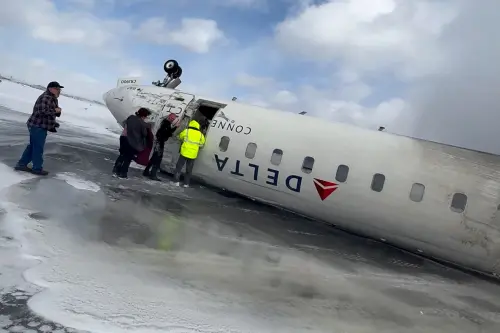A safety warning system activated in a Delta Air Lines regional jet, indicating a rapid descent before the aircraft landed and flipped over at Canada's largest airport in February, according to the country's Transportation Safety Board.
While nearly two dozen passengers sustained injuries, all 80 individuals on board flight DL4819, a CRJ900 jet operated by Delta's Endeavor Air subsidiary from Minneapolis-St. Paul International Airport, survived.
The plane touched down at a descent rate that was 50% greater than what its landing gear was designed to withstand, as noted in a preliminary report from the TSB, an independent transportation safety agency.
The sink rate warning sounded less than three seconds before landing, as stated by TSB investigator Ken Webster, who is overseeing the investigation.
U.S. aviation safety expert John Cox indicated that the flight was normal until the approach to Toronto's Pearson Airport, where the aircraft encountered a gust of wind at around 153 feet. In response, the first officer—who had 1,422 total flight hours and 419 hours on the CRJ—correctly reduced power, according to Cox.
About four seconds before touchdown, the gust subsided, leading to a drop in airspeed; however, the pilots did not increase power or pitch, Cox observed.
He described the situation as a distressing experience for a pilot, noting, "You can feel the airplane start to come out from under you. It's miserable." He emphasized the need for immediate action, which was not taken in this instance.
Cox also raised questions about why the captain, who had been with Endeavor Air since 2007 and had 3,570 total flight hours, did not increase power or implement other corrective measures to address the aircraft's descent.
The report indicated that the landing gear was designed for a descent rate of 12 feet per second, yet the aircraft was descending at over 18 feet per second upon touchdown.
Weather conditions at the time included a "gusting crosswind and blowing snow," as reported by FlightRadar24. Cox noted that while the conditions were challenging, they were within the capabilities of a professional pilot.
Delta declined to comment on the preliminary report, which does not assign causes. Under international regulations for air crash investigations, a final and more detailed report is expected approximately a year after the incident.
Webster confirmed that the TSB will provide specific reasons for the event in the final report.
Videos of the incident, showing the plane missing its right wing, circulated widely on social media. Some recent high-profile cases have been mentioned by U.S. airline CEOs as factors contributing to decreased domestic travel demand.
The report also highlighted that some passengers struggled to release their seatbelt buckles while inverted. "Injuries sustained by passengers occurred when they unbuckled their seatbelts and fell to the ceiling. The TSB is not aware of any seatbelt or seat failures during the accident."
